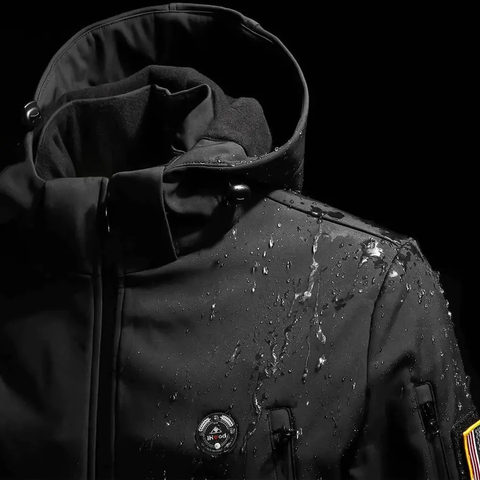Heated jackets have become increasingly popular in recent years, offering a convenient and efficient way to stay warm in cold weather conditions.
These innovative garments combine the functionality of a regular jacket with advanced heating technology, providing wearers with customizable warmth and comfort. This article will explore the latest technology behind heated jacket and how they work.
The main focus of this article is to shed light on the evolution of heated jacket technology and the various mechanisms involved in generating heat. We will discuss the different types of heating elements used, the power sources that drive these jackets, the control mechanisms for regulating heat settings, the safety features incorporated, the integration with smart technology, and the benefits they offer over traditional insulation options. Additionally, we will explore potential future trends and innovations in this field.
Evolution of Heated Jackets
Brief History of Heated Jackets
The concept of heated apparel dates back several decades, with the earliest versions of heated jackets primarily utilizing bulky wires and resistive heating elements. Over time, advancements in technology and materials have revolutionized the design and functionality of these garments. Today's heated jackets are sleek, lightweight, and highly efficient, offering a level of comfort and convenience that was unimaginable in the past.
Factors Behind the Development of Heated Jacket Technology
The development of heated jackets can be attributed to several factors. Firstly, the increasing demand for outdoor activities during colder seasons necessitated the need for reliable and efficient heating solutions. Additionally, advancements in battery technology and the miniaturization of electronic components made it possible to integrate heating elements into garments without compromising comfort or mobility. Moreover, the rising trend of wearable technology and the desire for personalized comfort have also contributed to the development and refinement of heated jackets.


Understanding the Heating Mechanism
Heating Technology Used in Jackets
Heated jackets utilize the principles of electrical resistance to generate heat. They consist of heating elements strategically placed within the garment, which generate heat when an electric current passes through them. The heat is then evenly distributed throughout the jacket, providing warmth to the wearer.
Types of Heating Elements Employed in Heated Jackets
Carbon Fiber: Carbon fiber is one of the most common heating elements used in heated jackets. It is lightweight, flexible, and has excellent electrical conductivity. Carbon fiber heating elements are typically integrated into the fabric of the jacket and provide uniform heat distribution. When an electric current passes through the carbon fibers, they heat up due to resistance, thus radiating warmth throughout the jacket.
Micro Coils: Micro coils are another type of heating element found in some heated jackets. These coils consist of fine wires wound into a coil shape. When an electric current passes through the micro coils, they heat up and provide warmth. Micro coils are known for their flexibility and efficiency in generating heat, making them suitable for precise temperature control.
Other Innovative Technologies: In addition to carbon fiber and micro coils, several emerging heating technologies are being explored for heated jackets. These include conductive fabrics with conductive fibers integrated into the fabric itself and printed heating elements, which use conductive inks to create flexible and customizable heating zones. These innovative technologies aim to enhance the comfort and performance of heated jackets.
Power Source and Control
Different power sources used in heated jackets
Battery-Powered Jackets: Battery-powered heated jackets are popular due to their portability and convenience. These jackets are equipped with rechargeable lithium-ion batteries that provide the necessary power to heat the elements. The capacity of the batteries varies depending on the jacket model and can range from a few hours to an entire day of heating, depending on the heat setting and usage.
USB-Powered Jackets: USB-powered heated jackets offer an alternative power source by allowing users to connect their jackets to external power banks or USB ports. This flexibility enables wearers to use a power source of their choice, such as a portable power bank or a USB port in a vehicle. USB-powered jackets are particularly useful for individuals who require extended heating periods or want to conserve battery life.
Control Mechanisms for Regulating Heat Settings in Heated Jackets
Integrated Controls: Many heated jackets feature integrated controls that allow wearers to adjust the heat settings directly on the jacket. These controls are typically located on the jacket's chest or sleeve and provide options to increase or decrease the temperature. They may also include additional features such as pre-set heat levels or timers for automatic shut-off.
Remote Controls: Some heated jackets come with wireless remotes that allow wearers to adjust heat settings without having to reach for the integrated controls. These remotes can be conveniently attached to the jacket or worn separately. Furthermore, advancements in smart technology have enabled the integration of smartphone apps with heated jackets, allowing users to control heat levels through their mobile devices.


Safety Features Incorporated into Heated Jackets
Overheat Protection: To ensure user safety, heated jackets are equipped with overheat protection mechanisms. These mechanisms monitor the temperature of the heating elements and automatically adjust the power or turn off the heat if it exceeds safe levels. This prevents the jacket from overheating and reduces the risk of burns or other hazards.
Automatic Shut-Off: Many heated jackets are equipped with automatic shut-off features to conserve battery life and prevent excessive heating. These features allow users to set a specific duration for the heating elements to remain active before automatically switching off. This prevents the jacket from continuously consuming power and ensures optimal usage.
Insulation Layers: Heated jackets feature insulation layers that provide a barrier between the heating elements and the wearer's body. These layers not only help to distribute the heat evenly but also protect the wearer from direct contact with the heating elements. Insulation materials such as polyester or down feathers are commonly used, ensuring both warmth and comfort.
Integration of Heated Jackets with Smart Technology
Mobile Apps and Bluetooth Connectivity: With the integration of smart technology, some heated jackets can be controlled through dedicated smartphone apps. These apps enable wearers to adjust heat levels, set timers, or access additional features directly from their smartphones. Bluetooth connectivity allows seamless communication between the jacket and the app, providing enhanced control and customization options.
Sensor Technology: Certain heated jackets utilize sensor technology to adjust the heat output based on the wearer's environment. These sensors can detect factors such as ambient temperature, humidity, or activity level and automatically adjust the heat settings to maintain optimal comfort. This feature ensures that wearers stay warm regardless of external conditions, making heated jackets adaptable to various climates and activities.
Compatibility with Wearable Devices: As the wearable technology market continues to expand, there is a growing potential for heated jackets to integrate with other wearable devices. For example, heated jackets could sync with fitness trackers or smartwatches to automatically adjust heat settings based on the wearer's activity level or heart rate. This integration would not only provide personalized comfort but also enhance the overall user experience by seamlessly connecting different devices.
Benefits of Heated Jackets
Advantages of Heated Jackets over Traditional Insulation Options
Heated jackets offer several advantages over traditional insulation options, such as down jackets or thermal layers. Firstly, heated jackets provide on-demand warmth, allowing users to control the temperature according to their preferences. This customization ensures optimal comfort in various weather conditions. Additionally, heated jackets eliminate the need for layering multiple garments, reducing bulkiness and providing freedom of movement. They also offer consistent warmth throughout the jacket, eliminating cold spots that can occur with traditional insulation.
The Versatility of Heated Jackets in Outdoor Activities and Weather Conditions
Heated jackets are designed to accommodate a wide range of outdoor activities and weather conditions. Whether it's hiking, skiing, camping, or simply commuting in cold temperatures, heated jackets provide reliable warmth and protection. Their versatility allows wearers to engage in outdoor pursuits without the discomfort of feeling cold, ensuring an enjoyable experience regardless of the weather.
Heated Jackets Provide Targeted and Customizable Warmth
One of the significant advantages of heated jackets is the ability to provide targeted warmth to specific areas of the body. By strategically placing the heating elements, such as in the chest, back, and sleeves, heated jackets can focus on warming the areas that are most susceptible to cold. Furthermore, the customizable heat settings allow wearers to adjust the warmth levels according to their personal preferences, ensuring an individualized and comfortable experience.


Future Trends and Innovations
Potential Advancements and Trends in Heated Jacket Technology
The field of heated jacket technology is continually evolving, with ongoing research and development focused on improving performance, comfort, and energy efficiency. Future advancements may include even more flexible and lightweight heating elements, longer battery life, and enhanced control options. Additionally, there is a growing interest in sustainable and eco-friendly heating technologies, such as integrating solar panels or utilizing energy-harvesting materials.
Ongoing Research and Development in the Field
Numerous companies and researchers are actively engaged in advancing heated jacket technology. Ongoing research focuses on improving the efficiency of heating elements, developing new materials with better conductivity, and exploring innovative ways to integrate heating technology seamlessly into garments. Additionally, collaborations between fashion designers, engineers, and textile manufacturers aim to create heated jackets that are not only functional but also aesthetically appealing.
Conclusion
In conclusion, heated jackets have evolved significantly over the years, driven by the demand for comfort, convenience, and personalization. They employ various heating mechanisms, such as carbon fiber and micro coils, to generate warmth through electrical resistance. The power sources range from rechargeable batteries to USB power banks, providing portability and flexibility. Integrated and remote controls allow users to adjust heat settings, while safety features ensure user protection. The integration of smart technology enables advanced control options and compatibility with wearable devices. Heated jackets offer advantages over traditional insulation options, providing targeted and customizable warmth for a wide range of outdoor activities and weather conditions.
The latest technology behind heated jackets combines practicality with innovation, providing wearers with a new level of convenience, comfort, and performance. These jackets not only keep users warm in challenging weather conditions but also offer customization options, safety features, and integration with smart devices. As heated jacket technology continues to advance, we can expect even more efficient and sustainable solutions that enhance the outdoor experience and redefine the way we stay warm in cold environments.


